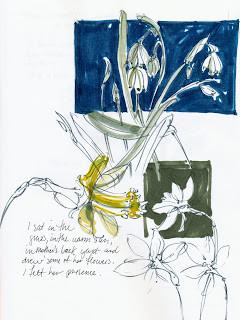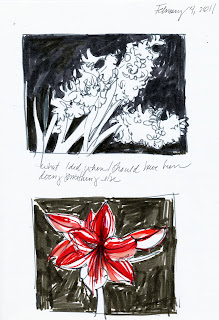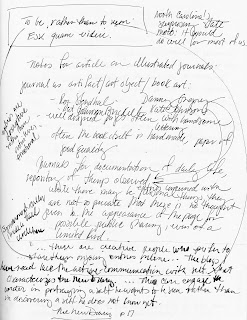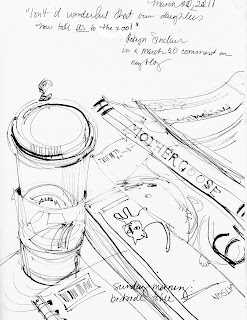Hello everyone,
Back three years ago when I posted this, there were many fewer people following this blog. Since the question comes up again and again, I thought I'd repost this. It's still my answer to the question about the uses of an artist's journal. My uses. My journal. Maybe yours, too?
Back then I mischaracterized/misunderstood Kate's journals... they ARE pretty and they do have lots of finished sketches, but, as she has often pointed out since then, they are way more than pretty and often NOT polished and arty. ;D.
I hope this is helpful. I could TRY to say this all again in a different way, but I decided not to ;D.
Wednesday, March 23, 2011
My big fat black journal
I’ve long been a fan of the kind of beautiful illustrated journal that Kate Johnson and others, like Roz Stendahl, Pam Johnson Brickell, and Danny Gregory, to give a few examples, produce.
Theirs are visually arresting books---almost art objects in themselves. They feature well-designed pages and handsome lettering. Often the books themselves are handmade, the paper of good quality.
While there may be entries of a personal nature, they are not so private that no thought is given to the appearance of the page for possible public sharing, even if the sharing is of a limited nature. In general, text and image are both important. The pages themselves may not be pristine. In Roz’s, Kate’s and Danny’s books, there’s lots of experimentation going on and many quick, quick sketches, but the overall effect seems to be of a well-made, nicely designed artifact. (I say ‘seems,’ because I have only seen these journals on line.)
My own illustrated journals, until recently, were different from these. They were more sketchbook than conventional journal, without a strong textual presence.
In those pages, I’ve practiced drawing because I LOVE it and so that I could become better at it. I’ve taught myself how to use watercolor, and, in more conventional journal-writing fashion, I’ve tried to get down on paper, in images, the important events and people in my life.
From the time I was about 8, though, I’ve written in diaries and journals. My sketchbooks were a thing apart from those written records of my life. For the past 6 years, my concentration on drawing and producing my blog Laurelinesput an end to my journal keeping.
A few months ago, I turned to writing in a journal again. In taking up journaling once more, I remembered the lessons I learned years ago from the powerful, transformative book, The New Diary by Tristine Rainer. Rainer advocates journaling as a means to communicate with oneself, to develop creativity, to solve problems, to enrich the inner life.
Emphasis is on freedom of expression, expanding consciousness, finding a state of flow ---and getting all of this down on paper any way you can. Well-designed pages? Good paper? Nice lettering? Well, unless you operate that way instinctively, intuitively, with your eyes closed, without censors or brakes... no.
When I restarted my journaling life, I had not planned to include imagery. Or not planned NOT to.
I just bought a big blank book (big enough to allow me to scrawl across a page) with mediocre paper (something that the sketching me would not have been happy about) and started writing.
And images appeared, there, along with the words!
Not as illustrations, but more the rough lineaments of daydreams or nightmares, the quick capturing of something my eye fell on as I paused in my writing, time outs from hard thinking, notes for paintings and projects, sometimes plain old documentation, too. The images are more fleshed out than doodles, yet only rarely are they anything close to polished art pieces!
The more the images appeared, the more I gave way to their flow. Now, I can hardly wait to see what will happen next!
Why I don’t KNOW what will happen next is because this new journal of mine is about process and not product. It’s about communication with the self, not with others.
And it’s about pulling together the various aspects of myself---myself the artist, myself the writer, myself the mother, wife, friend and all the rest... all in one place, between two covers of a regular old, big, black, blank book.
It’s an illustrated journal, but it doesn’t look like Kate’s, or Roz’s, or Danny’s, or Pat’s. It’s rough-hewn, private, with buckled and splattered pages, loaded with crossed-out words and wiggly arrows. It works for me. I write about it here as a way to show there are many ways to make this thing we call an illustrated journal and to say that maybe something LIKE this may work for you, too.

Theirs are visually arresting books---almost art objects in themselves. They feature well-designed pages and handsome lettering. Often the books themselves are handmade, the paper of good quality.
While there may be entries of a personal nature, they are not so private that no thought is given to the appearance of the page for possible public sharing, even if the sharing is of a limited nature. In general, text and image are both important. The pages themselves may not be pristine. In Roz’s, Kate’s and Danny’s books, there’s lots of experimentation going on and many quick, quick sketches, but the overall effect seems to be of a well-made, nicely designed artifact. (I say ‘seems,’ because I have only seen these journals on line.)
My own illustrated journals, until recently, were different from these. They were more sketchbook than conventional journal, without a strong textual presence.
In those pages, I’ve practiced drawing because I LOVE it and so that I could become better at it. I’ve taught myself how to use watercolor, and, in more conventional journal-writing fashion, I’ve tried to get down on paper, in images, the important events and people in my life.
From the time I was about 8, though, I’ve written in diaries and journals. My sketchbooks were a thing apart from those written records of my life. For the past 6 years, my concentration on drawing and producing my blog Laurelinesput an end to my journal keeping.
A few months ago, I turned to writing in a journal again. In taking up journaling once more, I remembered the lessons I learned years ago from the powerful, transformative book, The New Diary by Tristine Rainer. Rainer advocates journaling as a means to communicate with oneself, to develop creativity, to solve problems, to enrich the inner life.
Emphasis is on freedom of expression, expanding consciousness, finding a state of flow ---and getting all of this down on paper any way you can. Well-designed pages? Good paper? Nice lettering? Well, unless you operate that way instinctively, intuitively, with your eyes closed, without censors or brakes... no.
When I restarted my journaling life, I had not planned to include imagery. Or not planned NOT to.
I just bought a big blank book (big enough to allow me to scrawl across a page) with mediocre paper (something that the sketching me would not have been happy about) and started writing.
And images appeared, there, along with the words!

The more the images appeared, the more I gave way to their flow. Now, I can hardly wait to see what will happen next!

Why I don’t KNOW what will happen next is because this new journal of mine is about process and not product. It’s about communication with the self, not with others.
And it’s about pulling together the various aspects of myself---myself the artist, myself the writer, myself the mother, wife, friend and all the rest... all in one place, between two covers of a regular old, big, black, blank book.

It’s an illustrated journal, but it doesn’t look like Kate’s, or Roz’s, or Danny’s, or Pat’s. It’s rough-hewn, private, with buckled and splattered pages, loaded with crossed-out words and wiggly arrows. It works for me. I write about it here as a way to show there are many ways to make this thing we call an illustrated journal and to say that maybe something LIKE this may work for you, too.






